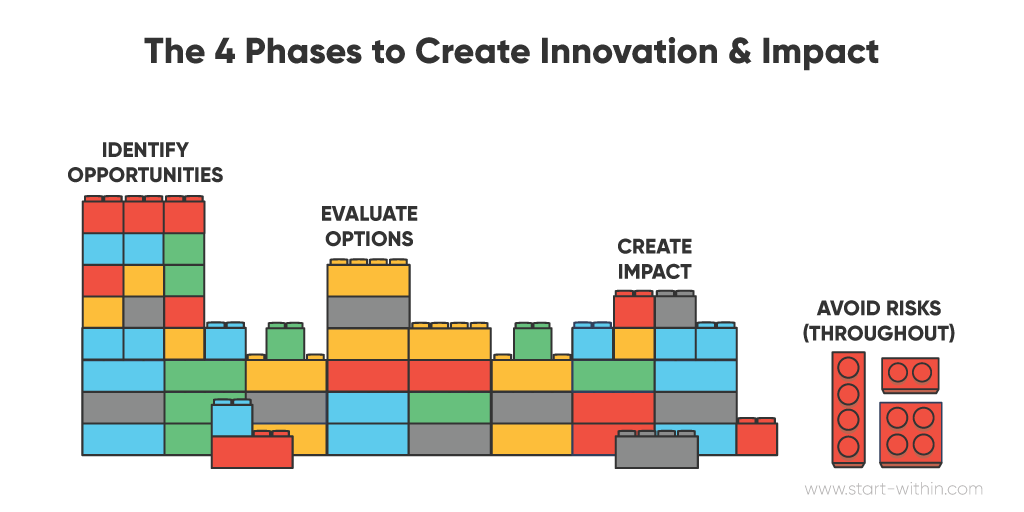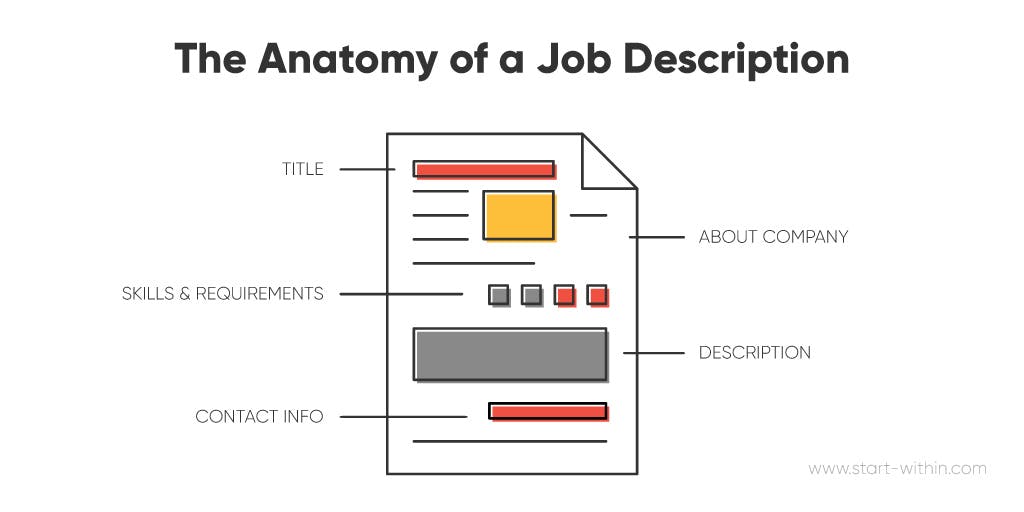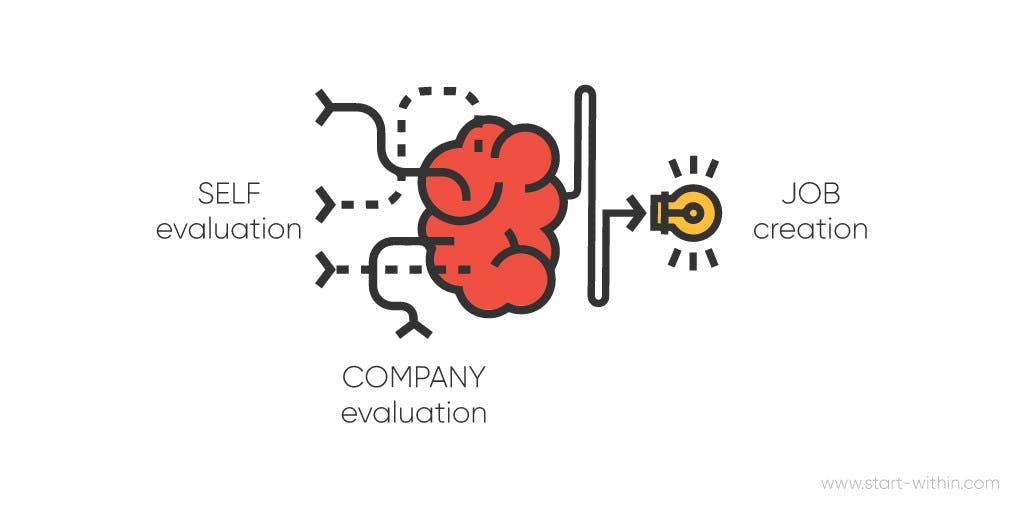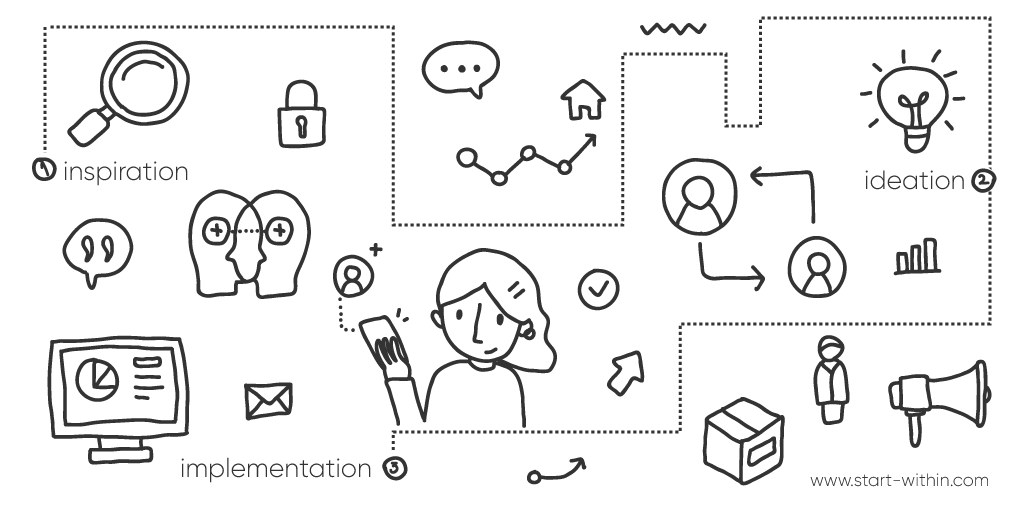
Before You Quit, Take These 5 Steps To Create A Better Job That You Actually Want
How To Make The Job You Have Today One You Are Passionate About. Seriously.
Did you know that your current job has entrepreneurial opportunities you may not be seeing?
In every established company (and even smaller ones), there are concrete steps you can take to breath new life into your workday and create a better job. You can get out of a rut and make your day job exciting and challenging, without the risk of taking on a drastic career change.
In This Article, You’ll Learn How To…
- Get support from your company to help launch new products and ideas
- Make an impact through the work you do
- Create autonomy in your positions through an entrepreneurial role for yourself
- And the steps for how to launch new products and ideas from within an existing organization or company
To get there, let’s start where you are today. You’re thinking about cutting the cord and quitting your job. I can definitely say, you’re not alone.
According to a major human resources study, 40% of surveyed employees gave serious thought to seeking new employment in 2017. More than 3.4 million LinkedIn users have privately signaled to recruiters that they are open to better job opportunities.
That’s a lot of people packing up their cubicle and quitting, but why?
Why Should You Quit Your Job?
Career resource site Monster found the reason most people want to leave their job is pretty simple:
- Are you frustrated with insufficient pay or unfair wage practices?
- Is a lack of honesty, integrity or ethics making you uncomfortable?
- Are there issues with work-life balance that’s allowed?
- Do you find that you don’t trust in the senior leadership?
- Or, is it just plain unhealthy or undesirable office culture?
Chance to Quit Your JobDepending on the severity, these can be BIG reasons to quit — today. In the U.S. alone, a steady 3 million people quit their job each month.
But if you are still contemplating the pros and cons of leaving vs. staying, there is a better question to ask:
How Can You Create A Better Job For Yourself?
Maybe you are looking to quit because you just want to make an impact at work.
Perhaps you are looking to quit because of a product idea that keeps you up at night. Or your side hustle that you know in your bones can be the next big thing.
Did You Know You Could Create Impact And Launch New Ideas In Your Current Job?
I’ve done both: starting a company and starting new products within an existing organization.
And I learned the surprising truth — entrepreneurial opportunities within existing companies can be more fulfilling than a startup.
I co-founded a company and did the entrepreneur thing. After an acquisition I did what many believe is the opposite — launched new products within a government agency.
Getting to innovate in important issues like public education was incredibly fulfilling. I got to launch educational technology products as a Fuse Corps Fellow within the California Department of Education and spent time working with the U.S. Department of Education.
After my whirlwind year of civic innovation, I landed my dream job at IDEO. There I joined the team to help launch a new product to teach creative problem solving, innovation, and design thinking to people across the globe.
I found that getting to launch new products within existing organizations is the entrepreneurial sweet spot. You get the support and resources to experiment without the headache of having to fundraise.
And, That’s What You’re Going To Learn In This Article. Together We Will Cover:
- Phase 1 – Identify The Signs Of Entrepreneurial Opportunities
- Phase 2 – Evaluate How And Where To Find A Better Job For You
- Phase 3 – 5 Steps To Create A Better Job & Opportunities For Impact
- Phase 4 – How To Avoid The Classic Landmines & Roadblocks
If you find the courage, clarity, and time to implement these steps, you’ll be on the path to creating the dream job you actually want without sacrificing stability in your current role.

Phase 1: How To Spot Entrepreneurial Opportunities?
Interesting fact: The very things that make you want to quit, may be signs that potential innovation and entrepreneurial growth are available. The reality that you notice these things makes you the perfect person to suggest new opportunities to start within your organization.
Is Innovation Part Of Your Company’s Core Business?
This question may seem obvious, but innovation can often get buried in the day-to-day job responsibilities of some of the most innovative companies.
If creating or utilizing new technology is built into the business model than there should be hope. In tech-savvy companies, there are many places where it is encouraged employees take on new opportunities.
These kinds of companies usually have a built-in organizational culture to support employees to speak up and step up.
Where they may fall short is in providing the formal program to do so (more on that below).
It will require more digging on your part, but if the company encourages a culture of innovation than there should be a fit for you to do new and challenging work. A place to create a better job.
Does Your Company Have A Formal Innovation Program?
Yes? Jackpot.
There are many different examples of corporate innovation programs and places to look within your company to find them.
The size and opportunity of the programs will vary. But even a small innovation program can prove to be potent; like an espresso delivering a punch to your Monday mornings.
Many companies have resources available for employees to “play” and prototype new ideas.
Hallmark’s LEaP Lab allows employees to test the latest hardware, software, and technology to create new products. From 3D printers to a hands-on wood shop, there are resources available for employees to learn, test, and launch their ideas.
Learning & Development
If you aren’t finding formal innovation programs at your company, you may see it within the Learning and Development department. These departments encourage employees to find their own learning opportunities, and will often sponsor all or some of the expenses.
GE’s BrilliantYOU takes it to the next level. At GE, there is a formal leadership institute where executives can get classroom innovation experience. And available to every GE employee they launched a series of online learning innovation initiatives through BrilliantYOU. On the platform, employees can login and gain access to the best online learning programs, right at their desk.
Innovation & Design Labs
Some companies have dedicated teams focusing on innovation full- or part-time with the goal of developing and leading innovation programs.
One model allows startups to set up a short-term residence within the company’s innovation lab. At BMW’s Innovation Lab, successful startups can participate in a ten-week program. The startups get mentorship and collaborate with BMW to test products and services in live customer environments.
Intrapreneur Program
The crème de la crème of innovation programs is the intrapreneurship program. I love when companies create platforms for employees to ideate and see their ideas launched within the company.
Adobe’s Kickbox is an intrapreneurship program where employees receive $1,000, and a self-contained innovation kit for creating and refining new ideas within Adobe.
Looking for places that innovation is encouraged will unlock new opportunities for a better job you at your company.
Now take it a step closer in and evaluate the team and leadership surrounding your current role.
Is Your Boss Collaborative And Inclusive Or Is Your Boss A Full-On Rule-Following, Authoritarian Asshole?
If you are on a team with high levels of collaboration and inclusiveness, then you are sitting pretty. There IS something you can do with that.
Collaborative leaders invest time in building relationships, constructively handle conflicts, and share control with team members. These traits are clutch to create an innovative workplace, ripe for entrepreneurial opportunities.
But If You Are Considering Leaving Your Job, It’s Likely You Don’t Have A Collaborative Boss.
Surveys find most that leave a job do so to get away from their manager. A whopping 84% of employees quit because they had a bad boss.
The research confirms that the worker-manager relationship is key to job satisfaction. Over half of surveyed employees noted that when they feel they can approach their managers with problems and questions, they feel engaged in their work.
When you find that you are up against an autocratic leadership style, or just an all-around awful boss, performing your job responsibilities can be more difficult.
It’s a challenge to manage up to your boss. You can’t magically make your boss better by being a better employee.
To Cope With Your Boss, And Set You Up To Be Able To Move Around Within Your Company, There Are Some Things You Can Do:
1. Refer to your job description
Going through your job description is a great way to review your responsibilities and duties and understand expectations.

Understanding your job description can help identify where you are expected to perform. It also gives you a place to outline what is missing to create a better job and your dream role. More on how to do that below.
First, take a look at your job description and create a list:
- What job responsibilities or expectations are you delivering on?
- How would you prove value and track performance?
- Where are things unclear (i.e., it oozes into someone else’s job responsibility)?
- What are things missing that you wish you could work on or would like to do to grow?
Second, talk to your manager or boss about alignment and your performance. The conversation could be during a scheduled performance review or more likely, will require you to ask your manager to set aside time. Ask to schedule a one-on-one to walk through the job description and identify places of clarity and growth.
2. Written communication is key
Keep your boss informed of all communication you may have with his/her boss and with your clients.
This can be a tedious and infuriating task. But when dealing with an insecure or narcissistic boss, it will make a difference in creating a positive work relationship.
It is also essential that you document conversations via email, or through note taking.
When making a request or clarifying something, an email is often the best way to get a quick response. It also creates a record of your conversation.
Take notes in all meetings to record requests, action items, and question anything that isn’t clear. Written notes will ensure your open laptop doesn’t distract others. Or look like you are working on something else. If it is kosher to have a laptop during a meeting, it is better to take your notes electronically. You can keep an open, running document (Google Docs is perfect for this) to outline conversations.
Share the document with your boss. You get the bonus of showing interest in tracking expectations and referring to it for to-dos and action items. Should things go south, your thorough documentation will serve as a timeline. Your notes will be useful if you have to go to HR with your problems in the future.
3. Be open to the learning experience and don’t take it personally
It won’t be the last time you have to work with a difficult person. I promise.
Remind yourself that it isn’t personal. Try to identify the creative ways in which you cope. Keep your focus on the long-term goals you have for your career.
Yes, your boss is difficult. You aren’t the first (or the last) to recognize this. Changing their personality or working style isn’t in your control.
While it may be hard, take it in stride and put your energy on what you can do to make things better — like finding and creating a better job on another team (more on how below).
Does Your Company Have Flexible Work Policies And Practices In Place?
Can you work from home or do you have flexible work hours?
Whenever there is flexibility in the where or when you work, you are within a culture that encourages flexibility in your role.
If nobody is watching the clock and judging you by what time you arrive or depart work, it’s because that’s not what’s valued. What is valued is the output.
When your company values output, you can uncover new opportunities to flex your entrepreneurial muscles.
Does Your Company Set Out To Make A Difference In The World?
Of course, your company is focused on the bottom line. Are they also doing what they can to create products, services, or experiences that make the world a better place?
Take a look at different departments within your company and look for examples of corporate responsibility that you can get behind.
Examples of corporate responsibility to look for include:
Environmentally Friendly Innovation
Your company works to reduce its carbon footprint for the good of the business and society as a whole. You can find this work through efforts like green energy choices and eco-friendly policies.
Employees like you can take the initiative and launch new environmentally friendly innovation programs. These projects reduce waste and expenses, improving the environment and net profit.
Corporate Philanthropy
Many companies make corporate donations of funds, time, or resources to the greater good of the community.
If your company is just starting to explore corporate responsibility, it will often support efforts of in-kind services to non-profits. It is an affordable to allow employees to give back to the community. Plus it provides a platform to share stories of impact.
You could find a worthy cause that employees at your company would be passionate about and launch a new corporate philanthropy program. Ideas like these can be even more fun if you co-lead with a colleague!
Ethical Labor Practices
Good companies treat employees fairly and ethically. This is especially relevant if operating across international locations with different labor laws than those in the U.S.
When a company wants to innovate around complex human rights issues, it is worth first understanding where the business operates. Then you can develop programs that incorporate human rights considerations into all aspects of operations.
You could research best practices around ethical labor practices and find inspiration for new programs at your company from companies that make their initiatives public. Both Hitachi’s outline of labor practices and Google’s Supplier Code of Conduct are excellent places to start.
Companies often outline how they execute on their commitment toward ensuring work conditions are safe, workers get treated with respect, and business operations conducted ethically.
Social Entrepreneurship
While corporate responsibility programs have become the sine qua non, major kudos for companies with initiatives focused on social entrepreneurship.
Social entrepreneurship programs encourage employees to pursue innovative solutions to the world’s most significant problems. It is a great place to recharge your passion for your work.
TIP: If you aren’t finding these formal programs at your company today, can you see a culture that would embrace the opportunity to launch new ones? Could this be the area to create a better job for yourself?
Is this something you could take on as a side project, to perhaps turn into your full-time effort in the future?
Phase 2: How To Turn Your Day Job Into A Better Job — Your Dream Job?
Now that you have an understanding of what conditions to look for within your company, it’s time to explore if you could find a niche. A place where you can launch new ideas, unlock a passion for your work, and create a better job for yourself.
There Are 2 Steps Required To Create A Better Job:
- Self-Evaluation
- Company-Evaluation

Why Is Self-Evaluation Important?
For doers and entrepreneurially-minded folks, it’s tempting to leap past step one and start orchestrating your perfect job.
But when was the last time you took a moment to self-reflect and identify what would make you happy? Your yearly review with your boss? Your coffee meet up with your mentor?
Take the time to ask yourself some soul-searching questions and reflect on them.
With reflection, you will find that what initially sounds exciting for an external reason (i.e., make more money, make my family proud, etc.) is hiding internal motivations that will indeed be the thing that you care about and want to do.
A Good Personality Test Can Get You Thinking A Bit Deeper About What Makes You Tick.
Before you roll your eyes and think it’s just a cutesy little quiz HR requires to see your “fit” with the company, there can be some personal gain in taking one and reflecting on the results.
One survey that is quick and similar to the popular Myers-Briggs Type Indicator is the (free!) 16Personalities test.
I took it with my team, and we all found it on point. It provides an accurate description of who you are and what motivates you. I landed on the Diplomat Protagonist personality.
Through the website, I could get strengths and weaknesses and a brief report to guide self-reflection.
Tests like these are simple tools for self-awareness. While they only provide a limited and simplified view of your personality, it can be a good starting point.
The Key To Successful Self-Exploration Is Talking About The Findings With Those You Work With, Or That Know You Best.
Share your report with a mentor or confident and ask his/her opinion on what resonates. Discuss how you might use this information to explore your career options. Once you have a sense of what drives and motivates you, you have a baseline for finding a better job for yourself.
Where Does My Company Need Me?
Entrepreneurs and intrapreneurs all face this question: Where is there a need and how can I fill it?
No matter where you sit in your organization, you have a unique perspective. You have the opportunity to find inefficiencies at work and fix them.
If you can find one that you value and care about, it’s a win-win for both you and the company.
There are 3 key places to look for entrepreneurial opportunities: the customer needs, employee needs, and company needs.
Start at the core, your company’s customers or clients, and build out from there. You may discover a niche for you to step into and create impact.
For each section, take a design thinking approach to creative problem solving and uncover new ideas and solutions.
New To The Concept Of Design Thinking?
I drink (read: guzzle) the design thinking Kool-Aid.
Design thinking is a problem-solving model created by IDEO, a design firm. It is the method to line up people’s needs with what is technologically feasible and economically viable to create value.
It’s the technique I use over and over to uncover new ways to solve the tough stuff. Whether creating a new product or design thinking with a state agency, it’s a robust framework to follow.
There are amazing, free resources from IDEO.org including the Design Kit. The kit includes an approach to creating innovative solutions and a step-by-step guide to getting started, ideating, and prototyping.
Using Design Thinking Tools Can Help You Create Impact, And Identify Entrepreneurial Opportunities.
The Customer Needs
Start at the core of why your company exists — the customer. Customer-centric thinking is one of the most fulfilling ways to innovate and one that is driving most businesses. The customer is the heart of your organization. Things to consider are the problems that your customer or client faces and how your company could address it.
Spend time with your customers. Whether that is one-on-one (preferred) or even just diving into their customer support questions or comments online.
Some of the customer-centric questions to ask include:
- What is the biggest challenge that you face in ___?
- How does our product/service help you?
- Where does our product/service have room for improvement?
- What else could we do?
There are countless other questions you should ask, but these are a good starting point. You will also need to go deep into the 5 whys interview tool to get to the causes of a problem.
The 5 Whys interview tool creates a process to delve deeper into the reasons. Asking 5 whys can uncover the factors that created the problem, thereby allowing for better problem-solving.
Example of Using the 5 Whys when you are unhappy at work.
You will have landed on the cause when asking “why” stops providing insights and you can go no further.
Interview customers for inspiration and take the time to sit back and brainstorm ideas around their problems. When brainstorming solutions, focus on a possible feature or upgrade to a product or service. Sometimes you will get faster traction and buy-in when you start small. It can be challenging to dive right into a big idea like launching a new product altogether (more on this below).
The Employees Needs
After investigating the customer needs, you can identify opportunities for innovation by looking at what your fellow employees need. This exploration begins by thinking about your own needs and by collecting employee feedback.
Ideas in this realm often fall under Operations but could also be built within departments like Recruiting, HR, or Learning and Development. The work covered by teams that focus on providing resources to the employees.
It’s a natural place to draw inspiration because YOU are the employee and you are surrounded by other employees.
Here are some tips to observe needs within your company:
- Take note when something is slowing you down
- Notice when things don’t align with the culture or values
- Listen to other employees when they talk about problems they face in doing their job
In following the design thinking process of observation, ask some questions to understand the employee’s needs:
- Is there anything about your job or company that is unclear or confusing?
- Do you see any roadblocks in carrying out your job duties?
- Would you like to change anything in the way things get done here?
- What part of your job do you wish you didn’t have to do?
Go deeper by finding an area you could apply the 5 Whys.
Common places to innovate will fall within things such as improving recruiting processes, employee retention, or day-to-day operations.
NOTE: Be careful in this area, ideas to improve employee experiences can sometimes fall within an existing department’s responsibility. There may be sensitivity around your suggestions if it feels like you are criticizing their work.
I will share more about how to walk this delicate line and avoid landmines below.
The Company Needs
Understanding your company’s needs for innovation requires big-picture strategy. This work usually sits at the CEO or executive level.
The C-suite can be an intimidating group to approach, especially in larger companies where you may not have interactions with the higher-ups.
It’s not an easy place to break through with new ideas, but it is possible and is indeed a place to look. Start by understanding and evaluating the company’s vision and mission.
Try to answer these questions:
- Why does my company exist?
- What are my company’s core values?
- Where does my company align with the core values and where does my company fall short?
- Where will your company be in 5 years? In 10 years?
When you understand the foundations of what makes your organization tick, it gives you the background you need to see where you could align with it in new and unexpected ways.
Just like in the outside world, when creating solutions, you have to start by observing and move to ideating solutions. After spending some thoughtful time in these phases, you can move into implementing your ideas to find a better job.
Phase 3: The 5 Steps To Creating A Better Job
Ready to shape your perfect job that allows you to have an impact and create value for your company? Follow these steps, and you will be on your way.
Step 1: Find Vacancies In Your Company
Start With The Low-Hanging Fruit: Where Is Your Company Hiring?
Identify if there vacancies within your company. Search for roles where you can leverage your experience and knowledge from your existing job, and innovate.
Depending on how your company announces job openings, you will need to set up a system to automatically get updates when a new job get listed. You want to stay in the know without having to check back every day.
If your company posts job opportunities on LinkedIn, you can set your LinkedIn account to notify you when there are new openings.
Go to your LinkedIn account, do a search for your company and location, and when prompted, create a search alert to be notified by text or email when a new job becomes available.
You can also sign up for a free account with Versionista or a similar site to monitor your company’s job posting page.
Just create an account, add your company’s career or job posting page you want to be tracked, and you will get notified when there is a change to the page.
If there are specific departments or teams that you see a fit, reach out to peers or hiring managers to learn more. Ask what the teams are up to and if there will be any job opportunities available in the future.
You may get in front of a job posting and learn about what’s in the pipeline to come, giving you the opportunity to explore your fit in advance.
It is far easier to create impact within an existing role than it is to try and create a new position.
Step 2: Take Your Research And Map Out Possible Solutions
Assuming there isn’t a defined role already written for you because often there just isn’t magical timing like this, take all that research you did and put it to work.
If you did your self-evaluation and have your company needs evaluation underway, you will start to see an overlap. Where there is a need that lines up with your talents — that’s the entrepreneurial opportunity to create a better job.
Here’s An Example Of How To Map Out Solutions:
Self Reflection:
Through self-reflection, you found that you find that you enjoy solving complex problems and are a strategic thinker. You also learned that you are empathetic and enjoy helping others.
Company Research:
Having spent time with recently hired employees to learn about improving their onboarding experience, you surfaced a problem: new hires feel lost and alone in your big company.
Brainstorm Solutions:
Now you get to start to brainstorm what solutions could improve the employee’s situation. Think about how you might be able to be a part of that.
Answer these questions to get one step closer:
— What are some solutions that I could do in my current role?
— Which ideas could I do as a side project in addition to my current role?
— Who leads these efforts already in the company?
— How can I approach this person to see if he/she is already working on this problem?
— In what ways could I assist this person in developing and executing on the solution?
Map out the design thinking approach you have been applying throughout this process: inspiration, ideation, and implementation.
Once you have started to connect the dots on the valuable research and conversations you have been having (inspiration), you can begin to nail down some potential solutions (ideation) and your role in making it happen (implementation).

Step 3: Think Small To Go Big
In identifying how you may be part of the solution, it’s important to think about solutions that bring on small-scale change. These smaller steps could lead to significant impact or opportunities for growth down the line. Stakeholder buy-in can be easier if you are starting with small experiments.
I have found so much inspiration from the Little Bets book by Peter Sims, and use this system to take small steps to get toward more substantial change.
This model is all about how to think creatively and solve the messy problems by taking little bets along the way.
In Looking At Your Solutions, Try To Focus In On Ideas That Can Be A Little Bet
Areas that are ripe for improvements with a smaller lift include things like a tweak or product feature added to an existing product. Or adopting a new tool that will create operational efficiency for a job task or team.
Don’t try to launch a new line of products out of the gate.
Think about what you would like to do that would be a small change toward improving your job day-to-day and make the world a better place.
Remember, even small changes can have a ripple effect and add up to more impact later down the line.
Step 4: Start Shopping Your Idea For Buy-In
Just like the startup world, you will have to start sharing your ideas and collaborating with others to shape the project or role.
Getting buy-in from stakeholders for your idea has three distinct phases:
Phase 1: Find Your Cheerleaders And Support Crew
Ask people in your company and see who agrees with the problem you are trying to solve.
Tips for identifying your cheerleaders:
- This could be the employee or team that is most affected by the problem.
- It may include a very vocal customer that has skin in the game as it relates to the problem.
- Or it may be outside of your company and include industry experts or the general public.
Your cheerleaders will serve one of two different purposes: to validate a solution meets their needs and to back you up in your efforts to get buy-in.
Phase 2: Start A Communication Campaign
Once you have come to some potential ideas that would solve the problem, you will need to start to communicate them to people so they can share feedback, give criticism, and help improve the solutions.
I find the easiest way to communicate ideas is to start with a PowerPoint presentation or Google Slide deck.
These tools create a visual space to capture themes and a note-taking area to make sure you cover your talking points.
Use an outline like the following to start capturing all your hard work:
- Problem: Here’s what you noticed.
- Research: Here’s what you did to get a more in-depth understanding (who you talked to, inspiration, etc.).
- Opportunities: Here’s what you think are worthy ideas to prototype.
Within each section, you will want to be concise, and transparent. Highlight the work others have contributed and show the collaboration that went into the work.
Ensure you convey all the research and thinking that you did, the conversations you have been having, and keep it open to multiple solutions. Remember, this isn’t a math problem. Never define or outline one, end-all solution. If it falls flat, you will have a harder time exploring other options.
IMPORTANT NOTE: You don’t want anyone’s first exposure to your ideas to be via your presentation. Be sure to talk about your work early, and often.
Phase 3: Identify Key Stakeholders And Decision Makers
In thinking about how to identify stakeholders, the goal is to find the people that will care about your solution. Who will the idea have an impact on and determine whether it will get the green light or not?
When you talk to decision makers, don’t try to create a formal presentation or meeting up front. Instead, use coffee meetups or casual run-ins as a time to mention the idea and get initial thoughts.
Because you are not formally leading the project idea (yet), you need to engage with the stakeholders informally.
Talk to peers to see if there are leaders in the company that are more open to ideas or if this idea is something that they may find interesting given their experience or role.
You want to find as many people as you can that fit into the following categories:
- The suggestion is part of their job description
- This would affect the employees/clients/customers that this person interacts with
- It is a solution that would make this person’s life easier or better
- The plan is similar to something this person tried in the past
- The idea would require resources from this person
Each time you find another person to talk to, and gather feedback on your idea, finish the conversation with two simple questions:
- What do you think about this problem we are trying to solve?
- Who else in the company should I talk to about this problem or idea?
IMPORTANT TIP: Be sure to follow up every conversation with a thank you email. I prefer a handwritten, mailed note, but I’m old school. At the very least, send an email to thank your contacts for sharing their time and follow up frequently with your progress.
It is difficult to talk to EVERYONE that will have an opinion on the matter. However, if you approach all your conversations with an open mind, and as a keen listener, you will reduce the risk of stepping on someone’s toes.
Step 5: Shape Your New Role
Once you have started to identify your cheerleaders, outline your idea, and identify key decision makers, you are ready to pitch your idea.
Start by speaking to the person that is most affected by any work you take on — your boss.
By the time you are ready to schedule a one-on-one, to ask for input and guidance, you should’ve already informed your boss on a few occasions about what you have been thinking about.
The Strategy For The One-On-One Is Threefold:
Goal 1: Show enthusiasm without coming off as a know-it-all.
Goal 2: Outline your research but make it clear that it has not distracted you from your job. Explain that you did the research on your own time, or how it relates to your existing role.
Goal 3: Get buy-in that there is a problem, and leave the door open to identifying solutions you could participate in.
You want to walk away from meeting with your boss knowing you are passionate and identifying what you can do moving forward.
What comes out of your one-on-one could be a request to share your ideas with someone else to get their feedback. Or your boss may have more questions and ask you to do further research and provide follow up answers.
The Best Outcome From The Meeting Is A Nod Toward How You Are A Self-Starter And That You Take Initiative.
You likely won’t get an immediate green light to create a new product and launch something big. But that will come with time and evolve.
One guarantee is that your initial idea likely won’t play out like you first thought it would. You will need to keep an open mind, ensure flexibility in your approach, and prepare to continue moving your idea forward.
NOTE: Always keep communicating with everyone that you have been talking to along the way. You never know when they will be able to open a door for you or support your cause in significant ways. If nothing else, it is an excellent way to show that you follow through on your work.
Phase 4: How To Avoid Landmines And Roadblocks To Innovation?
As I mentioned above, I almost never got complete buy-in on my ideas out of the gate. There are 3 key areas that will slow you down. Here’s how to deal with each:
There’s Always The Devil’s Advocate
Often one (or more) team member or person that you talk to that will fill the role of a devil’s advocate.
The devil’s advocate will point out all the problems with your ideas or solutions and typically won’t offer up any solutions.
Don’t ignore the devil’s advocate — the feedback can be more valuable than listening to people that agree with you!
This person is showing you flaws in your plans so you can go back to the drawing board and be sure to address them.
Listen to the devil’s advocate and try to include his/her points as things to research or consider in your solution.
Don’t take their negative feedback personally and instead use it to improve and move on.
Try Not To Step On Any Toes
If you work hard to communicate with many people, and often, you reduce the chances of unknowingly stepping on someone’s toes. But sometimes, things can be out of your control.
People with a big ego, or insecure in their roles, may take your ideas and initiative as hostile and try to stop you.
Try to see other’s perspectives and talk through how the idea or solution is meant to help him/her. You will get a lot further listening than ignoring them.
Tactfully responding and getting buy-in is easier said than done. Here are a few things that have worked in my career and for the people I’ve mentored:
Objection 1: We’ve Already Tried It, And It Didn’t Work.
What a deflating response. It’s not leaning into the idea but full on pushing it out with a definitive, we can’t/won’t and here’s why.
In hearing about what didn’t work, are you uncovering something that you didn’t know about? If it’s new information, that’s valuable feedback that you could take back and put thought behind to understand better.
Ask questions about what they tried, timelines, and why it didn’t work. Show genuine interest in learning and understanding.
Leave the conversation with an open-ended comment like, “This was so useful to learn about. I would like to think about these points and see if I can’t come up with some other ideas. Given your experience and tenure with the company, would you be willing to chat again after I have had some time to put some ideas together?”
Keep in mind the “we’ve tried it already” objection is not the end all, be all.
When I joined the California Department of Education, one of the projects I worked on had been tried and failed before me. Some people were hoping we could come up with a new solution, but many felt defeated from the failures.
I took the failures as learning opportunities and spent more time digging in with the people behind what “didn’t work.” This helped to uncover new ways for things that “could work.”
Sometimes it’s timing, sometimes it’s execution, and sometimes it’s just dumb luck. Whatever the reason, previous failures do not mean inevitable failures for the future.
Take the feedback, go back to the drawing board, and find some ideas that will be different than previous efforts.
Objection 2: You Don’t Have The Experience To Pull This Off.
Hearing this can be tough. And you will probably be told a version of this at some point in your career.
Instead of getting defensive, acknowledge that you are always looking to grow professionally.
Ask what things this person sees as places you fall short and take note. Recognize that whether the person’s reasons seem valid or not, their perception is their reality and one that you need to overcome.
Conclude the conversation by thanking the person for their candor and feedback on how you might grow.
Now, take the feedback and self-reflect.
What things can you work on or improve upon and spend time learning from others? With time, you will start to exhibit your growth.
In the meantime, find out where you do qualify, and take steps to help on that front. For example, maybe you don’t have enough experience in leading a massive project. Think about how you could break down the project into something smaller, and drive that first.
Take your time to understand where there are viewed shortcomings and identify where you can still carve out a place for you to create impact.
Objection 3: You Aren’t The Right Person For This Work.
There are 3 main reasons you may hear that you aren’t the right person for the job. Recognizing which camp you fall in is critical in understanding the next steps you take.
Reason 1: You aren’t the right person for this work because you aren’t the best person.
Square Peg Round Hole

It’s true, you may not be the BEST person to lead this solution, but maybe you are the best person to add new ideas to the conversation. Or perhaps you are the only person passionate about the problem.
Reasons for this response may be lack of job tenure in the company or skill sets that you have not displayed on the job yet. Acknowledging that there is supporting role for you, will give you the chance to be at the table when the right person is working on this project and could open doors for you down the line.
Ask if you could be part of the conversation or included in meetings. Your contribution at these early entry points can lead to a more formal role and increase the level of participation later.
Reason 2: You aren’t the right person for this work because someone else should be doing it.
Round and Square Peg

More often than not, an experiment or idea will fall into someone else’s job description. Maybe this person doesn’t have time for the project. Perhaps this person isn’t interested. Or the person has tried in the past and failed.
Accepting that there is someone else that may be expected to do the work allows you to figure out how to help. Is the project something that you could lead together, or could you help create a team of passionate people to assist this person?
It may not be the sole ownership you were planning for, but it can provide an unexpected co-founder. Take this as an opportunity to find a place to collaborate. Express your passion for the project and offer help where you think you would add value.
Focus on impact rather than the formality of who owns what.
Reason 3: You aren’t the right person for this work because you have other things to focus on/do.
Round Peg and Many Holes

This point can be a difficult one to argue. You were hired to do A, and you are asking to do B — how will you ensure that A has 100% coverage?
Is the concern that your current role or job would fall short? Do you have a big project on your plate or have you had a recent failure in execution?
Both are legitimate reasons for someone to believe you aren’t a good fit for taking on one more thing. It is your responsibility to show your ability to perform in your current role and in the capacity you are suggesting for the added idea.
Here Are Some Questions To Ask And Ways To Address The Concern Head-On:
Where Are There Places Of Overlap? What Are Things You Could Do To Further Your Idea That Would Also Benefit Your Current Role?
For example, if you are a product manager wanting to innovate for the customer, your customer interview questions could cover both product needs and your “other idea” needs. Win-win.
Career Growth Opportunity DiagramWhere Are There Places You Have Created Or Shown Improved Efficiencies? In What Areas Have You Found The Opportunity To Fill Some Time?
Let’s say you are in marketing and installed a new tool that automates marketing efforts. You could show how things are running smoothly on that front, giving you a little time to think about new market opportunities.
What Areas Have You Had Problems In The Past? Have You Heard About Places Where You Have Been Asked To Improve During Feedback Sessions?
If you have received criticism about your work, bring that to the conversation as well. Perhaps you have heard that you show interest in too many things, and seem distracted.
Create an outline of what you are focusing on now, making sure that it covers your current role entirely. Then add a couple of sentences that ooze into your idea. Define goals and objectives that will keep you on track and focused on performing in your current role, while giving a little space for the new work.
Don’t overpromise or forget about your outline. Hold yourself accountable to the items and follow up with your boss as you achieve your goals.
You May Hear “No”
At any point in your research and conversations, you may hear an outright “no.”
The goal is to bring people around to your ideas and solutions slowly, but somewhere along the way, you may hit a wall.
You Need To Evaluate How Hard The “No” Actually Is And Determine How You Can Pick Up And Move On.
Is the “no” from the person you report to?
If so, pause. Is there a good reason for the “no”? Assuming there is a good reason, you can use all your great research to apply to a different problem. Go back to the drawing board and think about a different “yes” you could work toward that will enable you to create impact.
Is the “no” because of time or resources?
Yes? That’s an opening for creative problem-solving. Suppose your idea required other team members get involved, or a large budget. Rethink the problem and come up with ways to prototype something smaller.
Here Are The Definitive Steps To Take To Turn “No” Into “Yes”:
- Acknowledge the concerns and hesitation (no matter how benign you think they may be – you may not have the complete picture).
- Give some space between the conversation. Sometimes people need to come around on their own time.
- After you have had time to allow the conversation simmer, approach with a different problem or question. If there was sensitivity around your first idea, sometimes rephrasing the problem can give you a new opening.
- Consider sharing an approach that could be a prototype executed by you, on your own time. Or with little to no budget required.
Try to get closer to a “yes” with a smaller solution, and you can continue to build up to something bigger down the line.
The thing to note is that anything good worth going after may take time, perseverance, and patience to achieve. It’s just like launching a company out in the wild. You may hear a “no” here or there before you land on the “yes” that will give you the better job you worked so hard to create.
Landing A Better Job
Finding opportunities to innovate within your company and make an impact may not be the easy path, but it is one of the most rewarding.
The skills in doing this get easier with practice and as you grow professionally, will open more doors and create more opportunities.
And even if you do quit, these lessons could be applied in your next role. Every job and company has an opportunity for innovation, and it is up to you to find the places that you are passionate about and can create the most impact.
How can you create a better job for yourself? Have you had success finding entrepreneurial opportunities within your company to improve the business and make a social impact?
"Douglas Ferguson has long been a top design sprint facilitator. In Beyond the Prototype, he delivers a practical guide to what comes after. If you've ever experienced the dreaded "post-sprint slump," this is an absolute must read. It will just completely up your game..”
—Greg Satell, Author of Cascades & Mapping Innovation
"Design Sprints have helped to evangelize design thinking. Douglas' pioneering work and subsequent tips are captured here. It's the perfect guide for the next wave of facilitators and teams looking to harness the power of user-centered prototyping."
— Jay Melone, Partner, New Haircut